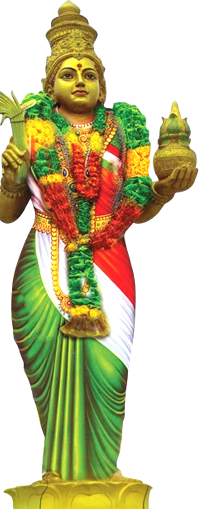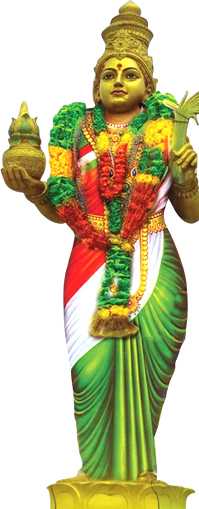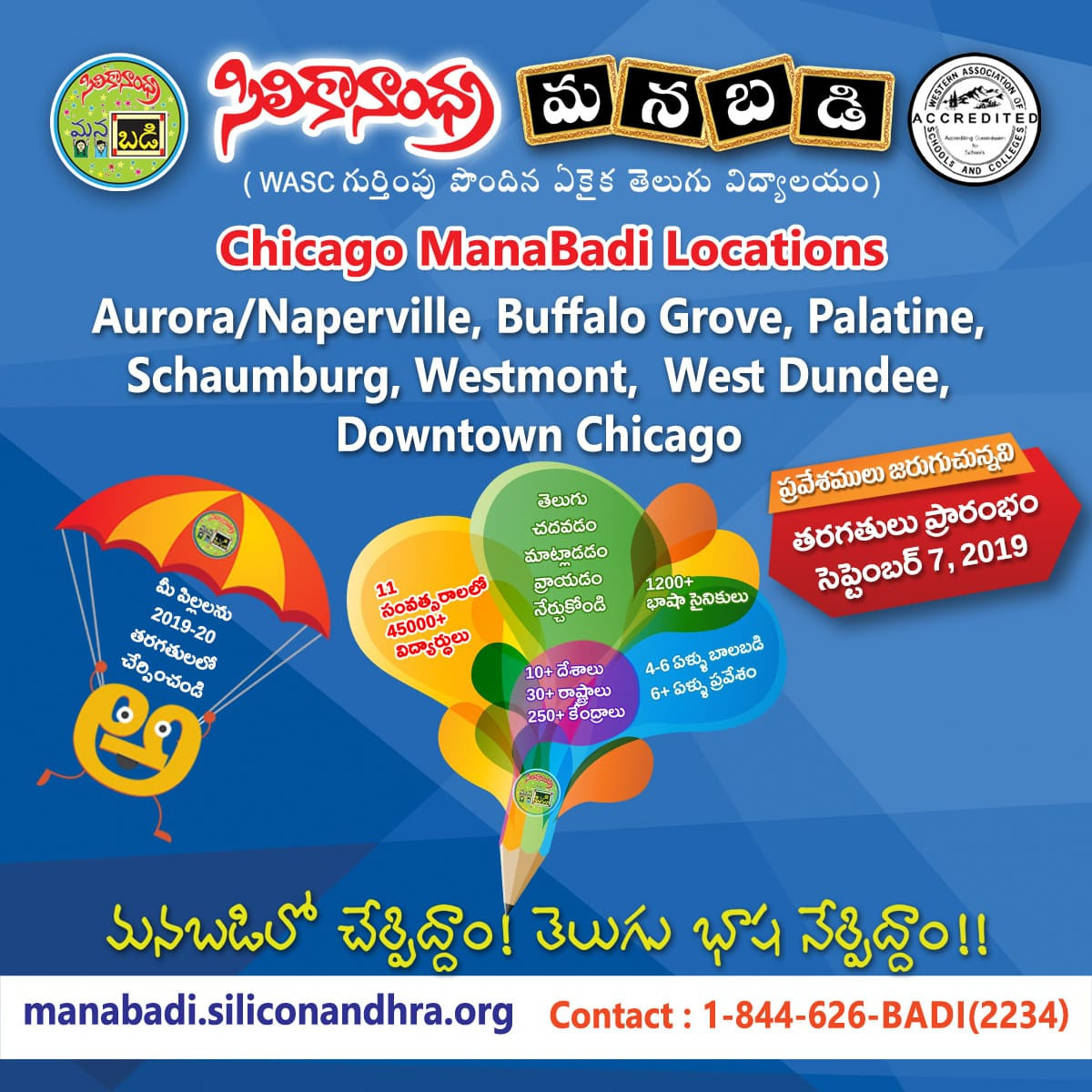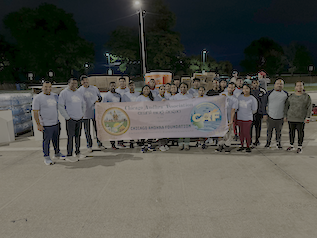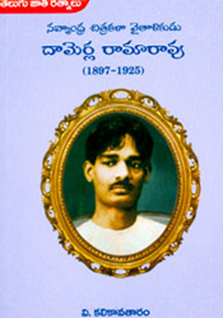
ప్రఖ్యాత కళాకారుడు శ్రీ దామెర్ల రామారావు
రామారావు గారు మార్చి 8, 1897 నాడు, దామెర్ల వెంకట రామారావు, లక్ష్మి దేవి దంపతులకు జన్మించారు. 5 గురు అక్క చెల్లెళ్ళు , 4గురు అన్న తమ్ముల్ళల్లో ఈయన రెండవ వారు. చిన్నప్పటి నుంచి ఆయన పెయింటింగ్, స్కేచ్చింగ్ మీద ఆసక్తి కనిపించేవారు. వారి మేనమామ గారు అక్కడ స్కూల్ లో డ్రాయింగ్ టీచర్ గా పనిచేసేవారు. అదే ఆయన్ని ఆర్ట్ మీద ప్రభావితం చేసింది కాబోలు! మేనమామ ప్రోత్సాహంతో పదేళ్ళవయసుకి చక్కని ప్రకృతి రమణీయ దృశ్యాలు గీయటం, అవి అందరి అభినందనలు అందుకోవటం మొదలయింది. కొబ్బరితోటల్లో కూర్చుని, గోదావరిగట్టు మీద కూర్చుని, లాంచీలో తిరుగుతూ ఒకటేమిటి? అనేక ప్రకృతి దృశ్యాలను చిత్రించాడు. అది గమనించి ఆయన నాన్నగారు ఆయనని ముంబై తీసుకెళ్ళి శ్రీ. సిసిల్ న. బుర్ణ్స్ , అప్పటి దేముంబై ఆర్ట్స్ స్కూల్ డీన్ కి పరిచయం చేసారు. ఆయన లోని కళ ను గుర్తించి వెంటనే ౩వ సంవత్సరం కోర్స్ లో అడ్మిషన్ ఇచ్చారు. మొదట్లో ముభావం గా ఉండే ఆయన్ని గుర్తించక పోయినా, క్రమేనా ఆయన చిత్రాలను చూసి అందరు మెచ్చుకోకుండా ఉండలేక పోయేవారు. చివరి సంవత్సరం లో చివరి సంవత్సరంలో ప్రథమ శ్రేణిలో ఉత్తీర్ణుడై మేయో బంగారు పతకాన్ని చేజిక్కించుకున్నారు. సర్ ఓ.జే. కౌల్ద్రే, బ్రిటిష్ ఆర్టిస్ట్, కవి, ఈయనని అజంతా, ఎల్లోరా గుహలకి తీసుకెళ్ళి అక్కడి ఫ్రెస్కో లని గీయడం నేర్పించారు.
కోర్స్ అయిపోయిన వెంటనే చిత్రకళశాలలో వైస్ ప్రిన్సిపాల్ ఉద్యోగానికి ఆయనకు ఆహ్వానం వచ్చింది. కాని రాజమండ్రికి తిరిగివచ్చి 1923 లో రాజమండ్రి చిత్రకళాశాల ని స్థాపించారు. 1919 సంవత్సరం లో ఆయనకి సత్యవాణి గారి తో వివాహం జరిగింది. నగ్న స్త్రీ ల చిత్తరువులని చిత్రించడం లో ఈయన మొదటివారి లో ఉండడం విశేషమే! చెప్పుకోవడం ఏమిటంటే, వైస్రాయ్ లార్డ్ రీడింగ్, ఆయన పెయింటింగ్, “గోదావరి అఫ్ ఈస్టర్న్ ఘాట్స్” ని ఎంతో మేచుకోలుగా కొనుక్కున్నారని!
1922 లో కలకత్తా చిత్రకళా ప్రదర్శనలో ఆయన ప్రదర్శించిన 'ఋష్యశృంగ బంధనం' చిత్రానికి ప్రథమ బహుమతిగా 'వైస్రాయి ఆఫ్ ఇండియా' పతకం వచ్చింది. అంతేకాకుండా రామారావు గారు చిత్రించిన గొల్లపడుచు, గోదావరి లోయ, నంది పూజ, పేరంటము, గొల్లపడుచులు, కార్తీక పౌర్ణమి వంటి రామారావు చిత్రాలు దేశ, విదేశాలలో ఎన్నో ప్రశంసలు పొందాయి. ఆయన పెయింటింగ్స్ లో ఒకానొక అద్భుతమైన పెయింటింగ్ “పూల ముడుపు “. ఆయన భార్య గర్భవతి గా ఉన్నప్పుడు, ఆయన ఈ పెయింటింగ్ వేసారు. అందులోని గర్భవతి ముమ్మూర్తులా సత్యవాని గారి లా ఉండడం విశేషం. “సిధార్థ రాగోదయం” మరొక ప్రసిద్ధమైన పెయింటింగ్.
1925 లో, 28 సంవత్సరాల వయస్సు కే ఆయన అందని లోకాలకి తరలి పోయారు. అంత చిన్న వయస్సు లోనే ఆయన 150 కి పైగా ఆయిల్/వాటర్ కలర్ పెయింటింగ్స్, ఎన్నో పుస్తకాల రూపం లో స్కెచెస్ , డ్రాయింగ్స్ వేసారు.దామెర్ల రామారావు గారి కళ చాల అనూహ్యమైనది. యెంతో డిటైల్డ్ గా, వ్యక్తికరణం గా (expressive), సహజత్వం ఉట్టిపడుతూ ఉంటాయో చెప్పలేము. ఆయనే కనుక మరి ఎంతో కాలం బతికి ఉంటె, ఇంకెన్ని కళా ఖండాలు సృష్టించి ఉండేవారో! ఆయన భార్య రాజమండ్రి స్కూల్ లో డ్రాయింగ్ టీచర్ గా పనిచేసారు. దురదృష్ట వశాత్తూ వారికి పిల్లలు లేరు. మరో రామారావు పుట్టలేదు, పుట్ట బోరు. ఆయన పెయింటింగ్స్ ని రాజమండ్రి ఆర్ట్స్ గేలరీ లో భద్రపరిచారు. కాని, దురదృష్ట వశాత్తూ ప్రస్తుతం అది ఆంధ్ర రాష్ట్ర ఆధ్వర్యం లో శిధిలావస్థలో ఉండడం విచారకరమైన విషయం.
-శైలజ సోమయాజుల
అమరజీవుల పరిచయ వ్యాసాలు
ఆంధ్రప్రదేశ్ రాష్ట్రం ఎంతోమంది స్వాతంత్ర్య సమర యోధులు, ఆదర్శ నాయకులు, ఆధ్యాత్మిక గురువులు, వాగ్గేయకారులు, కవి వైతాళికులు, రచయితలు, రాజకీయవేత్తలు, సంఘసంస్కర్తలు, దేశోద్ధారకులు, శాస్త్రవేత్తలు, విలేఖరులు, విద్వాంసులు, సాహితీ వేత్తలు, కళారాధకులకు జన్మనిచ్చిన నేల. ఆ మహనీయులు మనకందించిన స్ఫూర్తిని, నాయకత్వాన్ని, సాహితీ, సాంస్కృతిక, సంప్రదాయాలను అనుసరించటం, పరిరక్షించటం, మన భవిష్యత్తరాలకు అందచేయటం, ఆంధ్రజాతి విశిష్టతను నిలుపుకోవటం ప్రవాసాంధ్రులుగా మనందరి బాధ్యత.
ఎందరో మహానుభావులు అందరికీ వందనములు. ఆంధ్రులుగా మనందరం గర్వింపదగిన అట్టి మహనీయులను అందరికీ పరిచయం చేయాలనే ముఖ్యోద్దేశంతో “ఆంధ్ర వాణి” ఈ పరిచయ వ్యాసాలను మీ ముందుకు తెస్తోంది.
ఆంధ్ర కేసరి శ్రీ టంగుటూరి ప్రకాశం పంతులు:
శ్రీ టంగుటూరి 1872 సంవత్సరంలో ప్రస్తుత ప్రకాశం జిల్లాలోని వినోదరాయునిపాలెం గ్రామం లో జన్మించారు. చిన్నతనంలోనే తండ్రిని పోగొట్టుకోవటం వల్ల బీదరికంలో బాల్యాన్ని గడుపవలసి వచ్చింది. ప్రకాశం గారి తల్లి ఒంగోలు మునసబు కోర్ట్ ఎదురుగా పూటకూళ్ళు నడుపుకుంటూ ఆయనకు చదువు చెప్పించినట్లుగా ఆత్మకధ లో పేర్కొన్నారు. విద్యార్ధి దశ లో అల్లరిపనులతో గడిపిన ప్రకాశం గారు న్యాయ శాస్త్రం లో పట్టా పుచ్చుకుని 1894 సంవత్సరంలో రాజమహేంద్రవరంలో న్యాయవాదిగా వృత్తిజీవితాన్ని మొదలు పెట్టారు. ఆయన 1904లో మొదటిసారిగా రాజమహేంద్రవరం మునిసిపల్ చైర్మన్ గా ఎన్నికయ్యారు. తరువాత ఆయన లండన్ వెళ్లి బారిస్టర్ విద్యనభ్యసించి, ఉత్తీర్ణులయ్యారు. తిరిగి భారతదేశానికి వచ్చి మద్రాసు హైకోర్ట్ లో న్యాయవాదిగా చేరారు. 1921లో స్వాతంత్ర్యపోరాటం పట్ల ఆకర్షితులయి కాంగ్రెస్ పార్టీలో చేరి సత్యాగ్రహ దీక్ష తీసుకున్నారు, తన న్యాయవాద వృత్తిని వదిలేశారు. అప్పుడే “స్వరాజ్య” అనే పత్రికను ప్రారంభించి, దానికి సంపాదకత్వం నిర్వహిస్తూ ఇంగ్లీషు, తెలుగు, తమిళ భాషల్లో ప్రచురించారు. సహాయ నిరాకరణోద్యమం లో భాగంగా ౩౦౦౦౦ కాంగ్రెస్ స్వచ్చంద కార్యకర్తలతో గుంటూరులో ఆందోళన, ధర్నా నిర్వహించారు.
1928లో సైమన్ కమిషన్ ఏర్పాటు, వారి భారత పర్యటనను నిరసిస్తూ భారతదేశంలో నిరసనలు నిర్వహించబడ్డాయి. పోలీసులు నిరసనకారులపై అనేకచోట్ల కాల్పులు జరిపారు. మద్రాసులో జరిగిన పొలిసు కాల్పుల్లో పార్థసారథి అనే యువకుడు మరణించగా, పోలీసులు ఎవరినీ ఆ యువకుని దగ్గరికి వెళ్ళనివ్వలేదు. ప్రకాశం అక్కడికి వెళ్ళబోగా పోలీసులు ఆయన్ను కాల్చేస్తామని బెదరించి ఆపబోయారు. ఆగ్రహించిన ప్రకాశం తన ఛాతీపై చొక్కాను చించి మీకు దమ్ముంటే నా గుండెలపై కాల్చమని పోలీసులను సవాలు చేసారు. పరిస్తితి తీవ్రతను గుర్తించిన పోలీసులు వెనక్కితగ్గి ఆయనకు, మిగతా నిరసనకారులకు దారినిచ్చారు. ఈ సంఘటన తరువాత ఆయన్నందరూ “ఆంధ్రకేసరి టంగుటూరి ప్రకాశం పంతులు” అని సంబోధించనారంభించారు. గాంధీ గారి సన్నిహితులుగా home rule , సహాయనిరాకరణ , ఉప్పుసత్యాగ్రహం, క్విట్ ఇండియా ఉద్యమాలలో పాల్గొని కఠిన కారాగార శిక్ష అనుభవించి అస్వస్థత కు గురి అయ్యారు. కారాగారం లోనే " Monetary System of the world " , "Indian Monetary System " అనే పుస్తకాలను రచించారు.
శ్రీ టంగుటూరి ప్రకాశం 1946 ఏప్రిల్ 30 న ఉమ్మడి మద్రాసు రాష్ట్ర మ్ముఖ్యమంత్రిగా ఎన్నికయ్యారు. ప్రకాశం గారు దూరదృష్టి గల ప్రజానాయకుడు . ప్రత్యేక రాష్త్రం లో ఎన్నో కీలక మైన నిర్ణయాలను తీసుకున్నారు. అక్టోబర్ 1, 1953 లో ఏర్పడిన ప్రత్యేక ఆంధ్ర రాష్ట్రానికి మొదటి ముఖ్యమంత్రి గా పనిచేసారు. తిరుపతి లో శ్రీవెంకటేశ్వర విశ్వవిద్యాలయం, విజయవాడ లో కృష్ణా బారేజి నిర్మాణాలకు నాంది పలికారు. ఎన్నో ప్రజాహిత కార్యాలకు శ్రీకారం చుట్టారు. నూతన ఆంధ్రరాష్ట్ర నిర్మాత గా తెలుగువారి హృదయాలలో చిరస్థాయిగా నిలచారు. "నా జీవితయాత్ర" గా తన అత్మకధను వివరించారు. 1957 May 20 న అస్వస్థత వల్ల తుదిశ్వాస విడిచారు. ప్రకాశం గారి సంస్మరణ గా ప్రభుత్వం ఒంగోలు కేంద్రంగా ఏర్పాటు చేసిన నూతన జిల్లాకు ప్రకాశం జిల్లా అని పేరు పెట్టటం ఎంతో శ్లాఘనీయం.
శ్రీ పింగళి వెంకయ్య
జాతీయ జెండా రూపకర్త శ్రీ పింగళి వెంకయ్య విజయవాడ వాస్తవ్యులు. మహాత్మా గాంధీ కోరిక మేరకు దేశానికంటూ ఒక ప్రత్యేక జెండా ఉండాలని త్రివర్ణ పతాకాన్ని రూపొందించి తెలుగు వారికి గర్వ కారణమైనారు. శ్రీ పింగళి వెంకయ్య గురించి చాలామంది కి తెలియని మరికొన్ని విషయాలు ఈ శీర్షిక లో రూపొందిస్తున్నాము . శ్రీ పింగళి వెంకయ్య 1876 ఆగస్టు 2 న జన్మించారు. తండ్రి శ్రీ హనుమంత రాయుడు. కృష్ణ జిల్లా లో ప్రాధమిక , ఉన్నత విద్యలు పూర్తి చేసి 19 సం . వయసులో దక్షిణ ఆఫ్రికా వెళ్లారు. అక్కడే గాంధీజి తో పరిచయం కావటం జరిగింది. తిరిగి స్వదేశం వచ్చిన తరువాత కొన్నాళ్ళు ఉద్యోగం చేసి రాజకీయ అర్ధశాస్త్ర అధ్యయనం కోసం కొలంబో వెళ్లారు. ఇంతేకాక జాపనీస్ , సంస్కృతం, ఉర్దూ భాషలు అనర్గళంగా మాట్లాడే దిట్ట. ఆయన వ్యవసాయ రంగం లో పరిశోధనలు చేసి సన్నని నూలు ఉత్పత్తి చేసే ప్రత్తి పంట ను కనిపెట్టారు.
1906 సo , కలకత్తాలోని కాంగ్రెస్ సభలో, బ్రిటీషువారు జెండా ఎగురవేస్తే ఎంతో ఆందోళన చెందిన వ్యక్తి వీరు. రవీంద్రనాథ్ టాగోర్ , బాలగంగాధర తిలక్, దాదాభాయ్ నౌరోజీ వంటి ఎందరో ప్రముఖులను సంప్రదించి మన జాతీయ జెండాను రూపొందించడమే కాకుండా 1916 లో " A National Flag Of India" అనే పుస్తకాన్ని రచించారు . ఆంధ్ర ఉద్యమ భాగంగా 1913 లో బాపట్ల లో జరిగిన ప్రధమ ఆంధ్ర మహా సభల్లో శ్రీ పింగళి ఉత్సాహంగా పాల్గొని ఉపన్యసించారు. 1911 నుండి 1919 వరకు ఆంధ్ర జాతీయ కళాశాల , మచిలీపట్టణం లో అధ్యాపకులు గా పనిచేస్తూ కళాశాలను ఒక వ్యవసాయ క్షేత్రంగా తీర్చి దిద్దారు. అయన ఖనిజ శాస్త్రంలో కూడా అపారమైన విజ్ఞానం కలవారు. 1921 మార్చ్ 31 న విజయవాడ లో జరిగిన అఖిల భారత కాంగ్రెస్ కమిటీ సమావేశాలలో మహాత్మా గాంధీ శ్రీ పింగళిని ప్రత్యేకంగా ఆహ్వానించి జాతీయ జెండాను రూపొందించవలసినది గా కోరారు. కేవలం మూడు గంటల వ్యవధి లో మూడు రంగుల జెండాను రోపొందించి గాంధీ మెప్పును పొందిన ఆంధ్రుడు శ్రీ పింగళి. "జెండా ఊంచా రహే హమారా " అనే నినాదం తో ఎందరో భారతీయులు ప్రభావితం కావటానికి కారకులు . ఎటువంటి మాట విభేదాలకు తావు లేకుండా శాంతి,(తెలుపు) విశ్వాసం ( ఆకుపచ్చ) , సౌర్యాలకు (కాషాయ) ప్రతీకలు గా వీరు పేర్కొన్నారు . మధ్యలో రాట్నం చిత్రించడంలో భారత స్వతంత్ర ఉద్యమంలో ఏ జెండా ఎంతో ప్రాముఖ్యత వహించింది.
శ్రీ పింగళి ఎన్నో ఆందోళనలలో , ఉద్యమాలలో పాల్గొని నిస్వార్ధ దీక్షతో సేవలను అందించారు. బహుముఖ ప్రజ్ఞాశాలి గా ఖ్యాతి గడించిన శ్రీ పింగళి అవసానదశలో ఎటువంటి చరస్థిరాస్తులు లేకుండా దారిద్య్రం అనుభవించవలసి వచ్చింది . వీరికోసం 1963 లో శ్రీ కే.ఎల్ . రావు తదితరులు ఒక నిధిని ఏర్పాటు చేసినప్పటికీ అది ఆలస్యంగానే అందటం జరిగింది. శ్రీ పింగళి వెంకయ్య 1963, జులై 4 న అమరజీవులైనారు. త్యాగజీవి శ్రీ పింగళి చివరి కోరికగా మృత దేహం ఫై జాతీయ జెండా ను కప్పడం జరిగింది. మన జాతీయ పతాకంలో వారి కీర్తి చిరస్థాయి గా నిలిచిపోవటం నిస్సందేహం. జై హింద్
A History of Carnatic Music in Andhra Pradesh
By Usha Sandhya Appalaneni
India’s cultural history is steeped in a rich musical tradition. Beautiful melodies flutter from the pages of our history books, capturing the essence of our culture. The Indian classical music tradition dates back to Vedic times, featured most prominently in the Sama Veda. While the Sama Veda repeats the mantras from the Rig Veda, it adorns these words with melodies; chants are transformed into song. The musical notation in the Sama Veda is thought to be the earliest such record in human history.
Eventually, this early musical form diverged, emerging as the Hindustani style of the north and the Carnatic of the south. Carnatic music is built on four principles: sruti (pitch), swara (note), raga (melody), and tala (rhythm). While Carnatic compositions must be faithful to one of the 72 ragas, improvisation within the raga is a prized skill.
Innovation within this seemingly rigid structure of Carnatic music has produced some of the most beautiful works of Indian music. Of the many composers to embrace Carnatic music, the best known are acknowledged as the Trinity: Tyagaraja, Muthuswami Dikshitar, and Syama Sastri. Of these three pillars of Carnatic music, two have their roots in Andhra Pradesh.
Syama Sastri, the oldest of the Trinity, was born in 1762 in Tiruvaiyaru, Tamil Nadu. However, boasting a Telugu heritage, his works were composed in Telugu and Sanskrit. Syama Sastri produced around 300 compositions, many in reverence of Goddess Kamakshi. His compositions are celebrated today for their poetry and literary finesse. Among his works are the three peerless svarajatis, known collectively as the Ratnatrayam, or “three jewels”.
Tyagaraja was also born in Tiruvaiyaru in 1767 to a Telugu family hailing from Kakarla village of Prakasam District in Andhra Pradesh. Though he spent most of his life in Tamil Nadu, his compositions reflected his Telugu heritage. At least 700 kritis are attributed to Tyagaraja, most were composed in Telugu and in praise of Lord Rama. Tyagaraja is most well known for his Pancaratna Kritis, or “five gems”.
Tyagayya is perhaps the most loved of the Trinity, as evidenced by the many festivals held in his honor. The best known is the Tyagaraja Aradhana, held annually in Tiruvaiyaru. Here, thousands of musicians gather for a weeklong celebration of his contributions to Carnatic music. The highlight of the event is the Pushya Bahula Panchami, during which musicians sing his pancaratna kritis in unison.
Annamacharya, predating the Trinity, was born in 1408 in Kadapa district of Andhra Pradesh. One of the most prolific composers in the history of Carnatic music, he is said to have composed 32,000 sankeertanas in prayer to Lord Venkateswara, though only about 12,000 survive today. Lost for several centuries, they were rediscovered on copper plates hidden inside the Sri Venkateshwara Temple in Tirumala. Annamayya’s beautiful poetry was brought to life again through the Annamacharya Project. His contributions to Carnatic music are remembered at the Annamacharya Vardhanti in Tirumala every year.
Kshetrayya, a Telugu poet and composer, was born in the village of Movva in Andhra Pradesh in 1600. He is celebrated for his contributions to Carnatic music in the padam format. Of his thousands of compositions, only some have survived the centuries since their inception. Even so, his poetry is highly valued, adopted today in both dance and musical performances. A devotee of Gopala, his mudra “Muvva Gopala” appears in each of his padams.
Music permeates the history of Andhra Pradesh. These artists were trailblazers who changed the face of Carnatic music. As we cherish their works, however, we recognize that music continues to evolve. The last century has seen many innovative musicians, whom we will recognize in the articles to come.
A conversation with: AmmaBy Usha Sandhya Appalaneni
It started with me asking my mother to teach me her recipes, tweaked and perfected over the years. One afternoon, she called me downstairs to show me how to make sambar. She pulled a tin out of the drawer and began adding spices from it to the oil heating over the stove. I looked at that circular tin, which I had seen hundreds of times before, with its seven smaller circular tins nestled inside, each filled with a different spice.
I remarked that I wanted a tin like this for my own and started jotting down Indian kitchen equipment: pressure cooker, idli patra, grinder for making dosa pindi, kavvam to make buttermilk.
"We used to make buttermilk differently, you know," my mom said. First, they made the yogurt directly in clay pots. They used a long wooden rod with a rope wrapped around it to churn the yogurt into buttermilk.
 "They held one end of the rope in each hand, pulling at each end to twist the rod back and forth. One fumble and the rod would drop and break the fragile clay pot. But they were so experienced that they never made a mistake. I really admired their skill.
"They held one end of the rope in each hand, pulling at each end to twist the rod back and forth. One fumble and the rod would drop and break the fragile clay pot. But they were so experienced that they never made a mistake. I really admired their skill.
"There are so many skills like this that needed to be passed down through the generations. I remember that our elders would come to our home every year to help us restring the beds. They would sit on either side of the wooden bed frame, passing the rope between them, tugging and weaving, to make the nulaka mancham.
 "The nulaka mancham was made of rougher material so it was kept outside. They used the stalks of a gongura plant to make the rope. The stalks were soaked for about a week until the fibers, called gogunara, could be easily separated. These were then collected and sundried before woven into ropes.
"The nulaka mancham was made of rougher material so it was kept outside. They used the stalks of a gongura plant to make the rope. The stalks were soaked for about a week until the fibers, called gogunara, could be easily separated. These were then collected and sundried before woven into ropes.
"There was also the navaru mancham that we had to restring. These were made with flat cotton ropes.They were considered the nicer cots so we kept them inside the house.
"Every summer, we used to have thati aakula pandiri. It's a kind of palm tree leaf that we use to cover the overhang in front of the home. For some people's homes, these leaves covered the whole roof, not just the overhang. When you remake the roof with new leaves, it makes the temperature underneath very cool. Once we made the new pandiri, our neighbors would come over to sit under its shade. We spent many afternoons under it, exchanging stories."
As we talked, mom went to stove to make chai. "Family would get together to do many things like this. All of the festivals were really just excuses for family to travel to see each other. Festivals were different then. I was seeing some photos on Facebook this year of the Vinayaka Chaviti celebrations in my village. All the young girls were wearing jean pants and white tee shirts. It doesn't feel like a special day. We used to wear pattu langas.
"I used to go to the river with my friends a week before the festival to collect the bed clay and shape it into our own Vinayaka idols. We set them out to dry in the sun until the first day of the festival. That morning, we would get up early and set off to the fields to collect leaves and flowers. We spent hours doing it, because we all wanted to be the one to collect the largest variety flowers.
"By that time, my mother would have gotten some flowers from neighbors to do the pooja herself. Eventually, I would come home with my sack stuffed with flowers and leaves, angry that she didn't wait for me. So my mother and I would do the pooja all over again. At the end of the festival, we would took our idols back to the river to do nimajjanam and share some prasadam."
 I watched as my mom strained the chai and divided it into two cups. We sat, sipping our chai as we continued talking. "I saw some photos recently of a friend's daughter getting a mogali rekula poola jada. It brought back so many memories. I know you love the scent of malle poolu but this is an even better scent. Actually, they're not flowers but the leaves of the plant that we arranged into flower shapes.
I watched as my mom strained the chai and divided it into two cups. We sat, sipping our chai as we continued talking. "I saw some photos recently of a friend's daughter getting a mogali rekula poola jada. It brought back so many memories. I know you love the scent of malle poolu but this is an even better scent. Actually, they're not flowers but the leaves of the plant that we arranged into flower shapes.
"When you gather the leaves, you have to be careful because there are always snakes nearby. Apparently, snakes love this scent because it is intoxicating and makes them drowsy. But we would go to gather the leaves, anyway, because it was so much fun to make the jada."
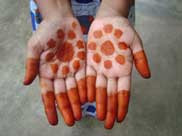 I mentioned that when we went to village, someone would always find fresh gorintaku for me. I loved the simple polka dot pattern my grandmother used to set over my palms. "It was so much work to get our hands on the gorintaku leaves. Only a few houses in the village had a tree. So we would beg them to let us gather some leaves until we eventually wore them down. And we picked the leaves very carefully; it was a luxury so you couldn't waste a single leaf."
I mentioned that when we went to village, someone would always find fresh gorintaku for me. I loved the simple polka dot pattern my grandmother used to set over my palms. "It was so much work to get our hands on the gorintaku leaves. Only a few houses in the village had a tree. So we would beg them to let us gather some leaves until we eventually wore them down. And we picked the leaves very carefully; it was a luxury so you couldn't waste a single leaf."
We kept talking about other traditions as my mom shared her memories with me.I loved getting a glimpse of her world. Growing up in the US, I only saw this world on summer holidays. I hope that you will share your memories with your children, as well. They may also want to hear your stories and learn about your childhood. Start the conversation and see where it takes you.
Subscribe
